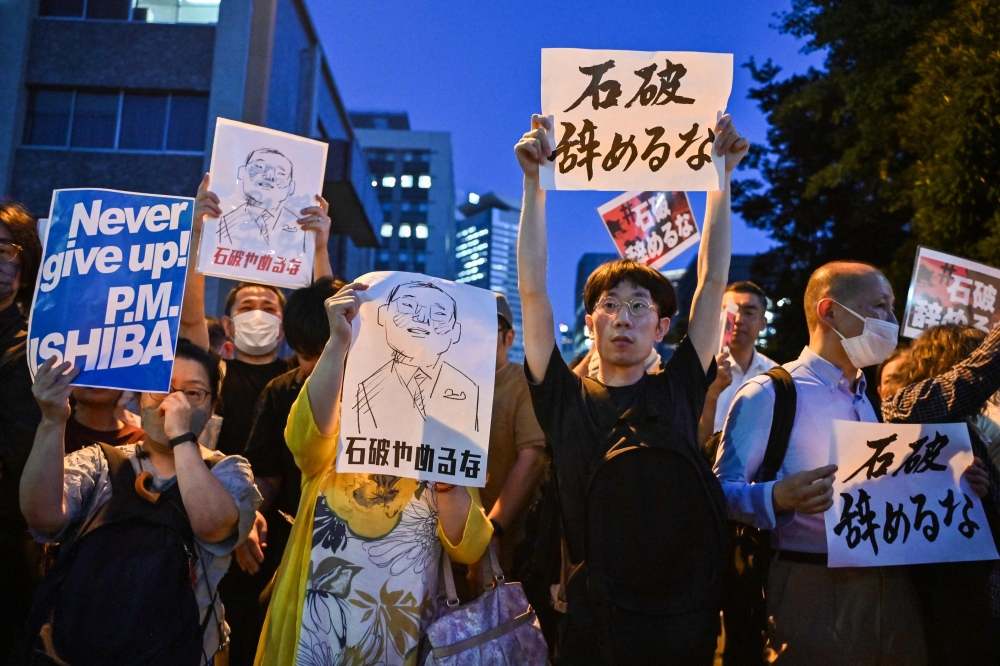TOKYO, July 26 — Japanese Prime Minister Shigeru Ishiba’s future is uncertain but an unlikely campaign for him to stay was growing online this week, including from people who are his natural political opponents.
The life raft has emerged since upper house elections on Sunday deprived Ishiba’s coalition of an upper house majority, months after it suffered a similar disaster in the lower chamber.
Despite Ishiba, 68, insisting that he has not discussed his resignation with members of his Liberal Democratic Party (LDP), multiple reports say that it is just a matter of time.
Some conservative members of the LDP are collecting signatures to hold a special meeting to discuss a leadership election to oust Ishiba, Fuji TV reported yesterday.
One reported signee is Sanae Takaichi, a hardline nationalist and onetime heavy metal drummer who lost a leadership contest to Ishiba in September.
Takaichi, 64, would likely run again to lead the party — and become Japan’s first woman prime minister if she wins — if Ishiba does depart.
The prospect of someone as premier with hawkish views on Japanese history and China has fuelled online calls for the moderate Ishiba to remain in power under the hashtag “#Ishiba Don’t quit”.
Supporters of Japan’s Prime Minister Shigeru Ishiba take part in a rally across the street from the prime minister’s office in central Tokyo July 25, 2025. — AFP pic
Some of the calls came from opposition politicians to the left of the LDP, including even from a Communist Party member of a local ward assembly.
Ishiba “is the most reasonable LDP leader in recent memory”, LaSalle Ishii, a newly elected lawmaker for the Social Democratic Party, said on X.
“If he resigns, a far-right government will be born,” the well-known comedian and voice actor said.
Taro Yamamoto, the leader of small opposition party Reiwa Shinsengumi, was among the first to voice concern about Ishiba’s replacement.
“The question is, if he were not to continue, who is going to replace him instead?” he told reporters during a Monday news conference.
“His economic policies are no good, but for Ishiba-san to continue, I think it’s a safe choice.”
A few hundred people participated in a rally outside Ishiba’s office Friday evening, with some holding up signs urging him to “never give up” and “persevere”.
Among them was 70-year-old Shigeru Koga, an opposition supporter who until the election day on Sunday had been calling on Ishiba’s government to be brought down.
But five days later, he said Ishiba is “still far better” than alternatives like Takaichi and Shinjiro Koizumi, the popular agriculture minister within LDP who Koga called “easily manipulable”.
“If the Takaichi government materialises, it would further give rise to forces like far-right Sanseito,” Koga said, referring to the upstart “Japanese first” party.
“To prevent that, and keep Japan safe, Ishiba must be brave and stand firm.”

A supporter (centre right) of Japan’s Prime Minister Shigeru Ishiba holds up a placard reading ‘Don’t quit Ishiba’ as he takes part with others in a rally across the street from the prime minister’s office in central Tokyo July 25, 2025. — AFP pic
Boomeranging tariffs
Shortly after the Sunday’s election, a Kyodo News survey put the approval rating for the Ishiba government at just 22.9 per cent.
But in that same poll, 45.8 per cent of the public believed there was no need for him to resign.
The LDP has governed almost non-stop since 1955, but voters have been deserting the party, including towards fringe groups like Sanseito.
Factors include rising prices, notably for rice, falling living standards, and anger at corruption scandals within the LDP.
The opposition is seen as too fragmented to form an alternative government.
But being in a minority in both houses of parliament means Ishiba’s coalition needs support from other parties to pass legislation.
This comes just as Japan faces multiple challenges, including a ballooning social security budget to pay pensions for its rapidly ageing and shrinking population.
A new trade deal announced this week with US President Donald Trump will see Japanese imports face a painful 15 per cent tariff, although this was lower than a threatened 25 per cent.
“We’ll evaluate it every quarter, and if the president is unhappy then they will boomerang back to the 25 per cent tariff rates,” US Treasury Secretary Scott Bessent said afterwards. — AFP








